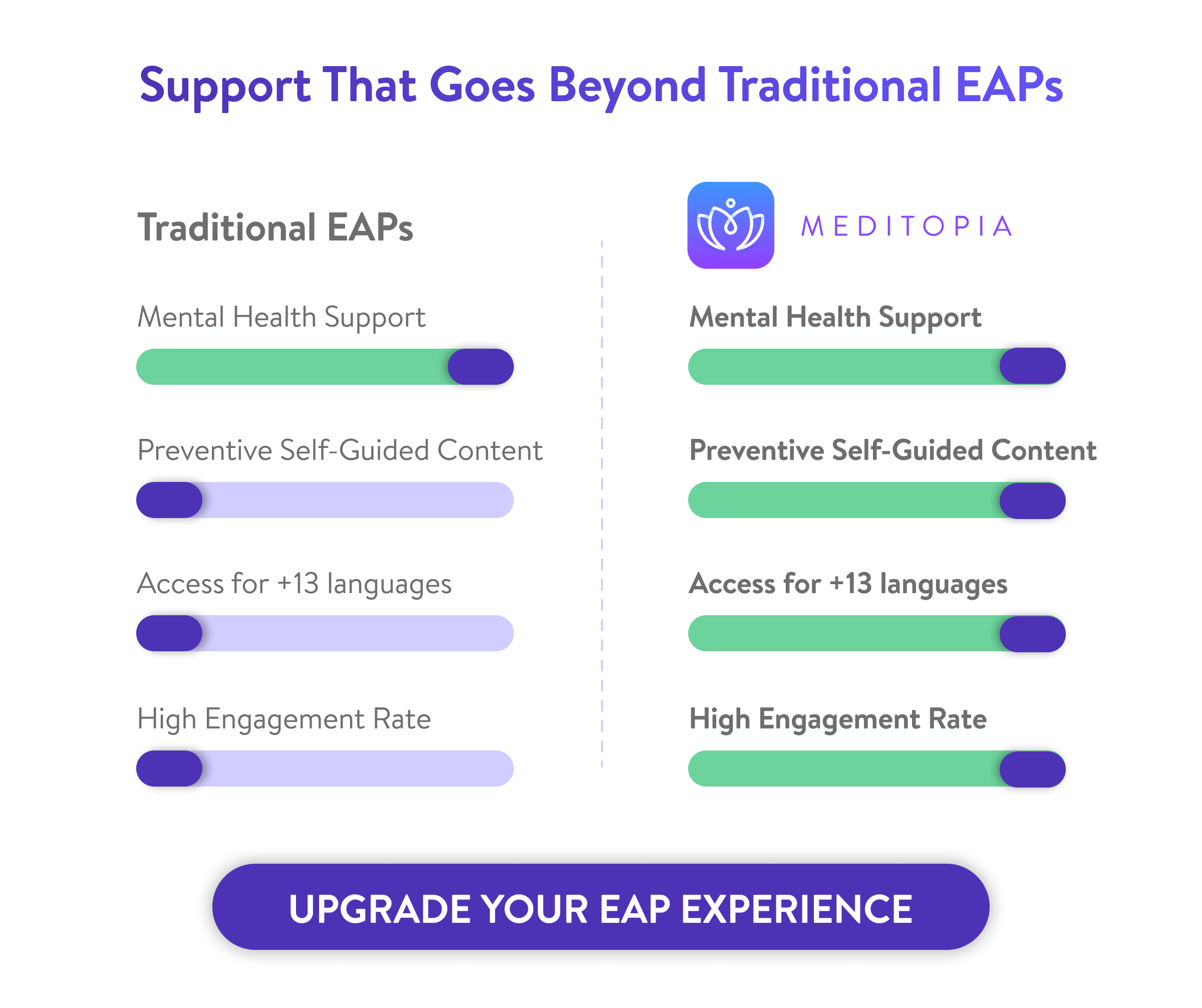By embedding reliable wellness infrastructure, from mental health support to digital self-guided content, companies can reduce absenteeism, improve retention, and demonstrate genuine care for their people. In this article we’ll explore why workplace wellbeing resources matter, what types of resources work best, how to pick the right solutions, and practical steps for implementation.
Why Businesses Need Dedicated Workplace Wellness Tools
Have you ever found yourself in a tornado of emotions before a presentation? Have you noticed employees being overreactive for no apparent reason? Sometimes work and personal lives collide, making people lose confidence, start conflicts, or diminish their productivity. Workplace wellness tools can change the game for many organizations, here's why:
- Globally, about 15 % of working-age adults are estimated to be living with a mental disorder, many of which go untreated, affecting their performance, attendance, and retention [1].
- In the U.S., workers who rate their mental health as “fair” or “poor” take nearly 12 days of unplanned absence per year, compared to ~2.5 days for those reporting good mental health [2].
- Between 2017 and 2023, mental health–related leaves of absence jumped 300 %, with a 33 % year-on-year rise in 2023 alone [3].
- Poor mental health at work also fuels presenteeism, where employees are present but operating below capacity. Contrary, workplaces that support mental well-being see reduced absenteeism and better productivity [4].
- Companies that prioritize well-being report productivity gains up to 20 % and lower turnover rates [5].
- Younger generations increasingly expect employers to be agents of holistic care, so offering support is not just compensation to them.
Types of Workplace Wellness Resources to Offer
To build a comprehensive wellness strategy, businesses should deploy a mix of corporate wellness resources, each addressing different dimensions of employee needs. Below is a table summarizing major categories of workplace wellness resources, followed by deeper explanation of each.
Popular Global Digital Wellness Platforms for Companies
With so many popular and excellent services globally, which one actually fits your unique organizational needs? Below is an overview of leading global wellness platforms that help businesses support mental health, engagement, and holistic employee wellbeing, followed by insights into what makes each stand out.

How to Choose the Right Wellness Tools for Your Workforce
Choosing the optimal combination of wellness tools and resources for your employees isn’t a one-size-fits-all decision. Here are key criteria HR leaders and decision-makers should evaluate:
- Workforce profile & demographics
- Are your employees mostly remote, hybrid, on-site, shift-based, or field staff? The tools should match how people work.
- What languages, cultures, and time zones must you support? For multinational teams, localization matters. Meditopia excells at it with content in 14 languages, and therapy in 5.
- Scope & modularity
- Prefer tools that allow modular rollout (e.g. start with mental health, then add fitness, financial coaching).
- Flexibility ensures you can expand or scale back without overhauling systems.
- Integration & interoperability
- The tool should integrate with HRIS, payroll, LMS, benefits systems, and employee assistance programs.
- That ensures smooth user experience and accurate data syncing.
- User experience & engagement design
- Is the interface mobile-first and intuitive?
- Does the vendor use nudges, push notifications, personalized journeys, gamification, and social features? These drive adoption.
- Reporting, analytics & dashboards
- Look for tools that deliver anonymized but actionable insights: usage trends, risk flags, cohort comparisons.
- Transparency and clarity in insights help leadership buy-in.
- Privacy, security & trust
- Ensure adherence to GDPR (or relevant local laws), encryption, anonymization, and clear opt-in consent.
- Vendors should provide data localization options if needed.
- Vendor reputation, evidence & clinical backing
- Check for peer-reviewed studies, white papers, case studies showing effectiveness.
- Ask about certification of content, collaborations with mental health professionals, and whether the platform follows evidence-based frameworks.
- Cost model & ROI expectations
- Some platforms charge per employee per month; others use tiered or usage-based pricing.
- Estimate ROI over 1–3 years and plan for adoption ramp-up times.
- Sustainability & vendor roadmap
- Will the vendor continue evolving content, features, AI capabilities?
- Do they plan to support emerging needs (e.g. caregiver burnout, return-to-work trauma)?

Best Practices for Implementing Wellness Tools
Even the most advanced wellness tools and resources won’t make an impact if employees don’t know how—or why—to use them. Implementation isn’t just a rollout; it’s a culture shift. Here’s how to make your wellness initiatives truly stick:
- Start small, test, and learn:
Pilot your program with a small, engaged group. Gather feedback to refine the experience before scaling across teams. - Champion from the top:
When leaders use and advocate for wellness tools, participation multiplies. Model healthy behavior, take breaks, talk openly about stress, normalize wellbeing. - Communicate the “why” clearly:
Frame wellness as a performance enabler, not a luxury. Link it to retention, productivity, and engagement data to earn buy-in. - Train managers as wellbeing advocates:
Equip managers with HR wellbeing tools and scripts to talk about emotional and physical health confidently. This bridges the gap between policy and lived experience. - Integrate, don’t isolate:
Ensure your wellness programs link with your EAP, L&D initiatives, and benefits ecosystem. Integration simplifies access and shows continuity of care. - Use data to evolve your strategy:
Monitor which modules employees actually use (mental health support, financial coaching, or movement challenges) and adjust the offering accordingly. Meditopia can do this for you, but you'll always have access to your Dedicated Employer Dashboard. - Normalize wellbeing in company rituals:
Embed wellness check-ins in one-on-ones, celebrate participation milestones, and include wellbeing moments in all-hands meetings. - Adapt to hybrid realities:
Ensure both office and remote employees have equal access to tools and can participate in shared activities, even asynchronously.
Measuring the Impact of Wellness Resources
Modern organizations use data from mental health support, engagement dashboards, and culture surveys to guide a corporate wellness strategy that’s evidence-based, adaptive, and transparent. This not only ensures accountability but also positions HR as a key driver of organizational wellbeing.
Here’s how to measure what matters most:
- Define success metrics early:
Decide what success means for your company (reduced absenteeism, improved engagement, or lower healthcare costs). Align leadership on clear KPIs from day one. - Combine quantitative and qualitative data:
Pair analytics from your wellness platform with employee sentiment surveys. Use both “hard” (productivity, turnover) and “soft” (stress levels, morale) indicators. - Track usage by resource type:
Identify which categories (coaching, therapy, fitness, or nutrition) drive consistent engagement. This informs future investment in holistic wellbeing solutions. - Correlate wellbeing with performance:
Link wellbeing scores to business metrics like retention, sales, or quality. Even small improvements in emotional health can yield measurable productivity gains. - Leverage advanced analytics and AI:
Platforms like Meditopia offering AI powered tools for employee wellbeing can reveal patterns like rising stress in specific departments, before issues escalate. - Gather manager feedback:
HR should partner with line managers to observe behavioral shifts: improved communication, fewer conflicts, more collaboration. - Review financial impact:
Compare wellness investment against reduced turnover costs, absenteeism, and medical claims. Studies show a $3–6 return for every $1 invested when programs are well-implemented [6]. - Share success stories:
Numbers matter, but human stories amplify them. Collect anonymous testimonials showing how wellbeing initiatives improved real lives.
With Meditopia for Work, you can track every dimension of your wellbeing strategy in one place. Our dashboards translate real employee behavior into clear, actionable insights, helping HR teams refine their corporate wellness strategy and demonstrate measurable ROI. Send us a message to discuss effective solutions for your workforce today.

























